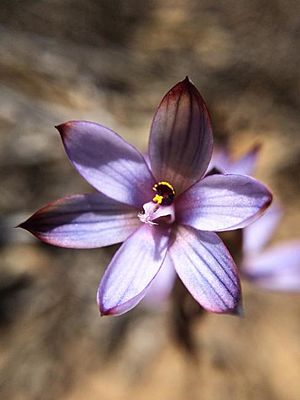Flushed sun orchid facts for kids
Quick facts for kids Flushed sun orchid |
|
|---|---|
 |
|
| Thelymitra canaliculata near Ongerup | |
| Scientific classification | |
| Genus: |
Thelymitra
|
| Species: |
canaliculata
|
| Synonyms | |
|
Thelymitra campanulata Endl. |
|
The Flushed Sun Orchid (Thelymitra canaliculata) is a beautiful wild flower found only in the south-west part of Western Australia. It's a type of orchid, which is a family of plants known for their unique and often colorful flowers. This special orchid gets its name because its blue flowers sometimes have a pink blush, making them look "flushed." It's also called the blue sun orchid because it loves to open its flowers on sunny days.
Contents
What the Flushed Sun Orchid Looks Like
The Flushed Sun Orchid is a plant that grows from a tuber (a swollen underground stem, like a potato). It's a perennial plant, meaning it lives for more than two years. It has one upright, thick leaf that is shaped like a line or a spear. This leaf can be about 20 to 35 centimetres (8 to 14 inches) long and 1 to 6 millimetres (0.04 to 0.24 inches) wide.
Each plant grows a tall stem, from 20 to 85 centimetres (8 to 33 inches) high. On this stem, you can find between three and twenty-eight flowers. These flowers are usually pale to dark blue with darker lines, and sometimes they have a lovely pink blush. Each flower is about 1.5 to 3.6 centimetres (0.6 to 1.4 inches) wide.
The sepals and petals, which are like the outer and inner "leaves" of the flower, are about 8 to 18 millimetres (0.3 to 0.7 inches) long. Inside the flower, there's a part called the column. This column is pale blue at the bottom and turns blackish towards the top. It's about 4 to 6 millimetres (0.16 to 0.24 inches) long.
At the very top of the column, there's a special part called the anther lobe. This lobe is blackish and has a yellow, jagged tip. The side parts of the column have fluffy tufts of white hairs, which look a bit like tiny mops. These orchids rely on insects to help them reproduce. Their flowers open up on sunny days, usually between October and December.
How the Flushed Sun Orchid Got Its Name
The Flushed Sun Orchid was first officially described in 1810 by a botanist named Robert Brown. He published its description in a book called Prodromus Florae Novae Hollandiae et Insulae Van Diemen.
The second part of its scientific name, canaliculata, is a Latin word. It means "channelled" or "grooved." This likely refers to the shape of the orchid's leaf, which has a groove down the middle.
Where the Flushed Sun Orchid Lives
You can find the Flushed Sun Orchid in specific, separate areas in Western Australia. It grows along the edges of swamps. These areas are mainly between the towns of Augusta and Albany. It lives in two special natural areas known as the Jarrah Forest and Warren biogeographic regions.
Conservation Status
The good news is that the Flushed Sun Orchid is currently considered "not threatened." This classification comes from the Western Australian Government's Department of Parks and Wildlife. It means that, for now, this beautiful orchid is not at risk of disappearing.

